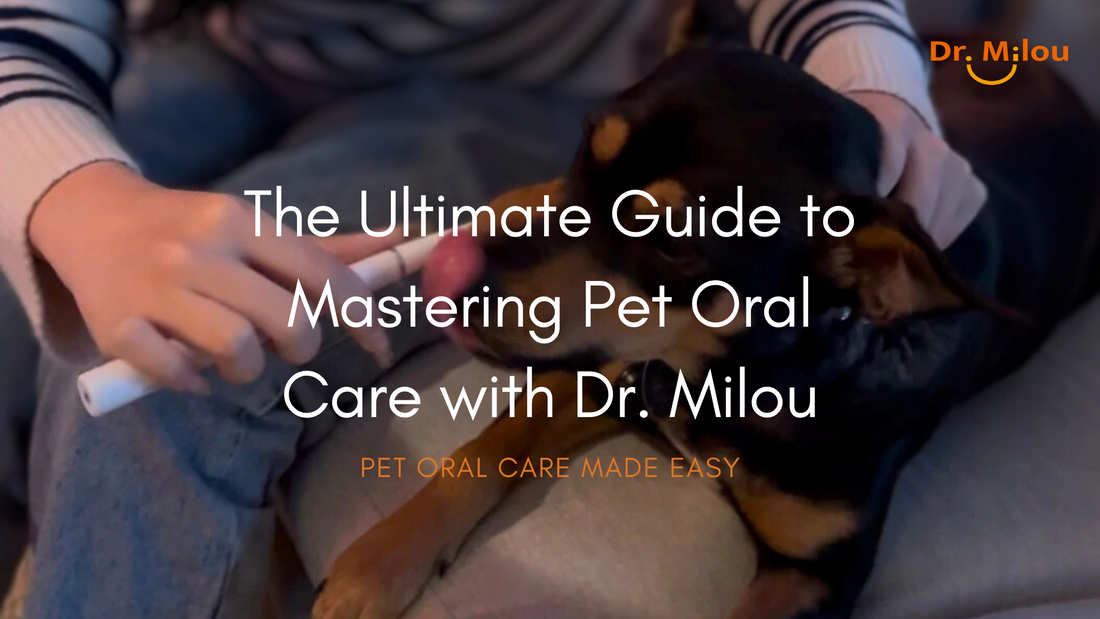
The Ultimate Guide to Mastering Pet Oral Care with Dr. Milou
Share
The Ultimate Guide to Mastering Pet Oral Care with Dr. Milou
Your pet’s oral health is vital for their overall well-being and happiness. With Dr. Milou’s electric toothbrush, you can ensure gentle and effective dental care at home, reducing the need for stressful and costly vet visits. However, we understand that introducing your furry friend to an electric toothbrush can be challenging, especially if they’re initially hesitant.
This comprehensive guide will walk you through every step of the process, ensuring a smooth transition for both you and your pet. By following these tips, you’ll create a positive, stress-free experience and pave the way for a lifetime of healthy smiles.
Table of Contents
- Why Pet Oral Care Matters
- Getting Started: Preparation Phase
- Week 1: Familiarizing Your Pet with the Toothbrush
- Week 2: Adapting to Vibration
- Week 3: Brushing Training
- Common Misconceptions and Troubleshooting
- Bonus: Introducing the Ultrasonic Dental Scaler
- Tips for Success
Why Pet Oral Care Matters
Did you know that 80% of dogs and 70% of cats show signs of oral disease by the age of three? Poor dental health can lead to:
- Painful infections
- Loss of teeth
- More severe health issues, such as heart or kidney disease
Regular oral care not only prevents these problems but also strengthens the bond between you and your pet. A healthy mouth means a happier, longer life for your furry friend. That’s where Dr. Milou’s electric toothbrush comes in—a gentle yet effective tool designed specifically for pets.
Getting Started: Preparation Phase
Before jumping into brushing, it’s essential to set the stage for a positive experience. Here’s how to get started:
1. Choose a Calm Environment
Select a quiet, distraction-free space where your pet feels safe. This could be their favorite spot at home, like their bed or a cozy corner.
2. Prepare Your Supplies
Gather everything you’ll need:
- Dr. Milou’s electric toothbrush (fully charged with a soft brush head)
- Your pet’s favorite treats for positive reinforcement
- A towel or mat to keep the area clean
By starting with the right environment and tools, you’re setting yourself up for success.
Week 1: Familiarizing Your Pet with the Toothbrush
Goal: Help your pet feel comfortable with the toothbrush (powered off).
1. Static Introduction (Days 1–2)
Place the toothbrush near your pet’s daily activity area (e.g., next to their bed). Let them sniff and explore it naturally. Reward them with treats every time they approach or interact with it.
2. Dynamic Introduction (Days 3–4)
Hold the toothbrush in your hand and gently move it in front of your pet. Allow them to sniff it and reward them each time. Gradually touch the toothbrush to their face or cheeks.
3. Simulating Brushing (Days 5–7)
Gently place the toothbrush in your pet’s mouth (powered off) and let it touch their teeth briefly. Use a brushing motion for a few seconds, then reward them generously.
Milestones for Progression:
- Your pet willingly approaches the toothbrush.
- They allow the toothbrush to touch their face and teeth without resistance.
Week 2: Adapting to Vibration
Goal: Introduce your pet to the sound and vibration of the toothbrush.
1. Sound and Vibration Introduction (Days 8–10)
Turn on the toothbrush and let your pet hear the sound from a distance (about 30 cm). Reward them for staying calm. Gradually reduce the distance over several sessions.
2. Light Contact (Days 11–14)
Hold the vibrating toothbrush near your pet’s lips or gums. Touch it gently for a second or two, then reward them. Gradually increase the contact duration.
Milestones for Progression:
- Your pet remains calm around the vibrating toothbrush.
- They tolerate brief contact with the toothbrush on their lips and gums.
Week 3: Brushing Training
Goal: Transition to full brushing sessions.
1. Initial Brushing (Days 15–17)
Gently touch the vibrating toothbrush to your pet’s teeth for a few seconds. Reward them immediately afterward.
2. Brushing the Outer Teeth (Days 18–19)
Focus on brushing the outer surfaces of a few teeth at a time. Hold the brush at a 45° angle to the gum line.
3. Complete Brushing (Days 20–21)
Gradually expand to brushing all teeth, dividing them into sections. Reward your pet after completing each section.
Milestones for Progression:
- Your pet tolerates brushing multiple teeth in one session.
- They remain calm throughout the process.
Common Misconceptions and Troubleshooting
Misconception 1: My pet is too scared to use an electric toothbrush.
- Solution: Desensitization is key. Start with the toothbrush powered off and take things slowly.
Misconception 2: Electric toothbrushes are only for severe dental problems.
- Solution: Regular brushing prevents dental issues, saving you costly vet visits in the future.
What to Do If Your Pet Resists:
- Stop immediately and return to the previous step they’re comfortable with.
- Use soothing words and extra treats to rebuild trust.
Bonus: Introducing the Ultrasonic Dental Scaler
For pets with stubborn plaque or tartar, Dr. Milou’s ultrasonic dental scaler offers a deeper clean. Its silent, vibration-free operation ensures a stress-free experience. Follow the same desensitization steps to familiarize your pet with the scaler.
Tips for Success
1. Patience is Key
Every pet learns at their own pace. Don’t rush the process—celebrate small victories!
2. Positive Reinforcement
Use treats and affection to create a positive association with brushing.
3. Build a Routine
Aim for 2–3 brushing sessions per week to maintain long-term oral health.
A Healthier Smile, A Happier Pet
Training your pet to accept an electric toothbrush takes time, but the benefits are well worth the effort. With Dr. Milou’s electric toothbrush for daily care and ultrasonic dental scaler for deep cleaning, you’re ensuring a healthier, happier life for your furry friend.
For more resources and support, visit drmilou.co and join our community of pet lovers dedicated to stress-free oral care.
